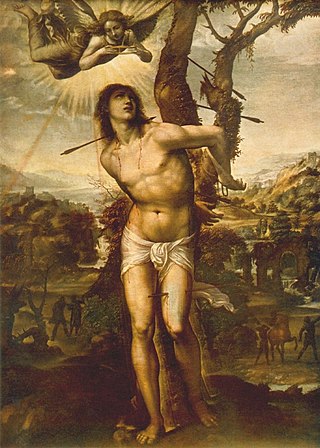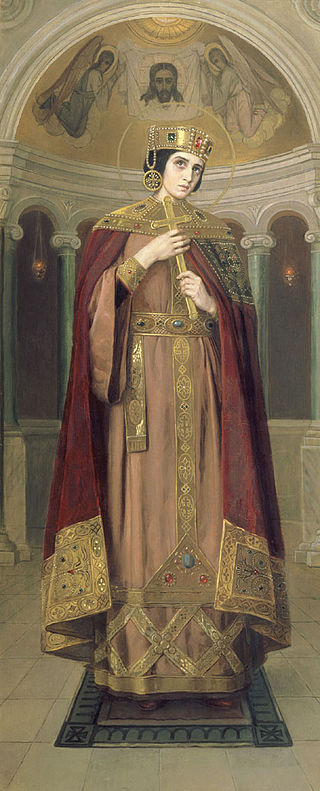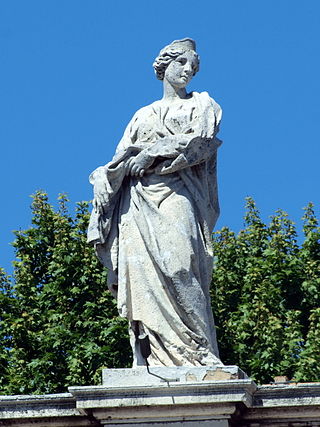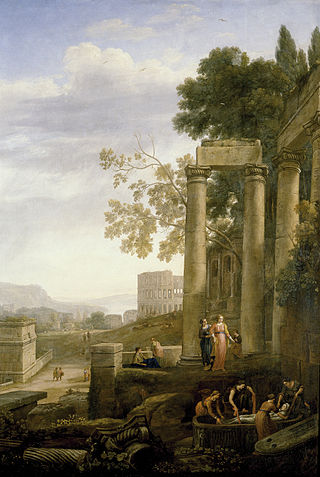
Pope Callixtus I, also called Callistus I, was the bishop of Rome from c. 218 to his death c. 222 or 223. He lived during the reigns of the Roman emperors Elagabalus and Alexander Severus. Eusebius and the Liberian catalogue list his episcopate as having lasted five years (217–222). In 217, when Callixtus followed Zephyrinus as Bishop of Rome, he started to admit into the Church converts from sects or schisms. He was killed for being Christian and is venerated as a saint by the Catholic Church.

Agnes of Rome is a virgin martyr, venerated as a saint in the Catholic Church, Oriental Orthodox Church and the Eastern Orthodox Church, as well as the Anglican Communion and Lutheran Churches. She is one of several virgin martyrs commemorated by name in the Canon of the Mass, and one of many Christians martyred during the reign of the Roman emperor Diocletian.

Sebastian was an early Christian saint and martyr. According to traditional belief, he was killed during the Diocletianic Persecution of Christians. He was initially tied to a post or tree and shot with arrows, though this did not kill him. He was, according to tradition, rescued and healed by Irene of Rome, which became a popular subject in 17th-century painting. In all versions of the story, shortly after his recovery he went to Diocletian to warn him about his sins, and as a result was clubbed to death. He is venerated in the Catholic Church and the Orthodox Church.

The Basilica of Saint Sabina is a historic church on the Aventine Hill in Rome, Italy. It is a titular minor basilica and mother church of the Roman Catholic Order of Preachers, better known as the Dominicans.

Saints Faith, Hope, and Charity , are a group of Christian martyred saints who are venerated together with their mother, Sophia ("Wisdom").

Marcella (325–410) is a saint in the Roman Catholic Church and Orthodox Church. She was a Christian ascetic in the Byzantine Era.

Prisca was a young Roman woman allegedly tortured and executed for her Christian faith. The dates of her birth and death are unknown. She is revered as a saint and martyr in Eastern Orthodoxy, by the Catholic Church, and in the Anglican Communion.

Saint Anastasia is a Christian saint and martyr who died at Sirmium in the Roman province of Pannonia Secunda. In the Eastern Orthodox Church, she is venerated as St. Anastasia the Pharmakolytria, i.e. "Deliverer from Potions". This epithet is also translated as "One who Cures (Wounds)" in Lampe's A Patristic Greek Lexicon.

Saint Pantaleon, counted in Western Christianity as among the Fourteen Holy Helpers of the Late Middle Ages, and in Eastern Christianity as one of the Holy Unmercenary Healers, was a martyr of Nicomedia in Bithynia during the Diocletianic Persecution of 305 AD.

Alexandra of Rome was a Christian martyr and saint, known from Martyrdom of Saint George as either Emperor Diocletian's wife or the wife of Dacian, a Roman Prefect. She is also sometimes mistaken with Priscilla or Prisca.

The Four Crowned Martyrs or Four Holy Crowned Ones were nine individuals who are venerated as martyrs and saints of Early Christianity. The nine saints are divided into two groups:
- Severus, Severian(us), Carpophorus (Carpoforus), Victorinus
- Claudius, Castorius, Symphorian (Simpronian), Nicostratus, and Simplicius

Saints Cyprian and Justina are honored in the Catholic Church, Eastern Orthodox Church and Oriental Orthodoxy as Christians of Antioch, who in 304, during the Diocletianic Persecution, suffered martyrdom at Nicomedia on September 26. According to Roman Catholic sources, no Bishop of Antioch bore the name of Cyprian.

Symphorosa is venerated as a saint of the Catholic Church. According to tradition, she was martyred with her seven sons at Tibur toward the end of the reign of the Roman Emperor Hadrian (117–38), or during the reign of Trajan.

The mythical Balbina of Rome, sometimes called Saint Balbina and Balbina the Virgin has been venerated as a virgin martyr and saint of the Catholic Church. As is made clear in the Catholic Encyclopaedia, it seems what follows has been nothing more than fable, not history.

Saint Leocadia is a Spanish saint. She is thought to have suffered martyrdom and died on December 9, ca. 304, in the Diocletianic Persecution.

Felicitas of Rome, also anglicized as Felicity, is a saint numbered among the Christian martyrs. Apart from her name, the only thing known for certain about this martyr is that she was buried in the Cemetery of Maximus, on the Via Salaria on a 23 November. However, a legend presents her as the mother of the seven martyrs whose feast is celebrated on 10 July. The Eastern Orthodox Church celebrates their martyrdom on 25 January.
Marcellus and Apuleius were third- or fourth-century martyrs who were inserted in the General Roman Calendar in the 13th century. They were recognized as saints by the Catholic Church, with 7 October as their feast day. Apuleius is considered purely legendary, and is no longer recognized.

Serapia was a Roman saint, a slave and martyr, also called Seraphia or Seraphima of Syria.

August 28 - Eastern Orthodox liturgical calendar - August 30

Landscape with the Burial of St. Serapia is a 1639–40 oil painting by the French artist Claude Lorrain. It was one of several paintings commissioned from the artist on behalf of King Philip IV of Spain. It is now in the collection of the Prado Museum in Madrid, Spain.




















